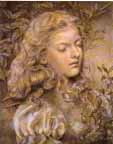
Emily Sandys's chalk drawing, Portrait of a Girl, elegantly depicts a young girl's head and shoulder amidst an assemblage of flowers. The girl's head turns to the right with her chin and nose tilting up. Her lips touch gently allowing her jaw to rest. The girl's eyes close with her brow relaxed, burden-less and impassive. Her wildly curly hair contrasts her smooth face as coiled locks wrap around her neck, framing her serene expression. Sandys draws cross-stitching in the area of the nap of the girl's neck. The ruffle on the shoulder of the girl's dress stands out in the drawing with bright white chalk highlights and bold curves.
Only the girl's head, hair and right shoulder compose her body in this work. A patch of a flowering plant emerges from the right corner of the paper to cover her chest area. The leaves of the plant blend in with the girl's curls, blurring the line between nature's bounty and woman's beauty. Behind the head of the girl, a clumping of holly rises as if the girl stands in or right in front of a holly bush.
Questions

1. The girl, although young, appears as elegant as any femme fatale of Dante Gabriel Rossetti. Her smooth face, fashionable dress and long curly hair are easy on the viewer's eye. Compare Portrait of a Girl to Rossetti's Lady Lilith. These two works feature beautiful females pressed up against flowering plants. Does this give any light as to why Emma Sandys drew this girl mysteriously surrounded by flowers?
2. Sandys draws only the girl's head and shoulders, a typical composition for a portrait. However, she atypically draws the girl with closed eyes. There are some other intriguing examples of females with closed eyes such as John William Waterhouse's Head of a Young Girl and Sir John Everett Millais's The Blindgirl. These women appear to be calm and comfortable, experiencing a moment of inner peace. What role does the viewer play in these works? Is the viewer a secretive intruder or accepted presence?
3. Compare Portrait of a Girl to Simeon Solomon's pencil drawing, Night and Millais's Portrait of a Girl: Sophie Gray. These wide-eyed female figures stare uncomfortably out at the viewer. Do these intense gazes effect the viewer any greater than Portrait of a Girl or do both these expressions grab the viewer's curiosity and wonder?
4. The flowering plants are the only outside elements added to this portrait. The holly has been interpreted by signify "foresight." There is a connection between the plant's leaves and the girl's curls as they intertwine. Flowers play an important role in many of Emma's brother, Frederick's paintings also, such as Margaret Slaughter. Are these artists attempting to connect nature and human beauty? Do these artists's successfully create closeness with nature in these drawings? What artists might have inspired them to use flowers in their works?
Bibliography
Marsh, Jan, and Pamela Gerrish Nunn. Pre-Raphaelite Women Artists. London: Thames and Hudson, 1998. 119-22.
Marsh, Jan, and Pamela Gerrish Nunn. Women Artists and the Pre-Raphaelite Movement. London: Virago, 1989.
Morgan, Hilary, and Peter Nahum. Burne-Jones, the Pre-Raphaelites, and Their Century. London: Peter Nahum, 1989. Catologue number 138.
Last modified 30 November 2002